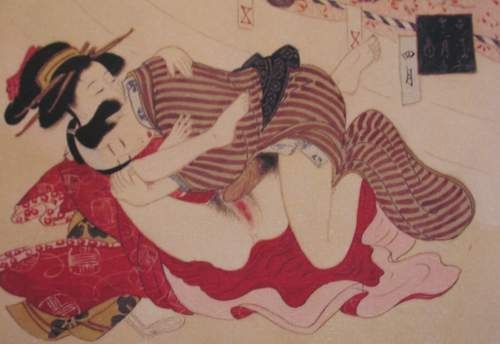What is Shunga? Artsy Editorial
- Posted on

At its best, shunga celebrates the pleasures of lovemaking, in beautiful pictures that present mutual attraction and sexual desire as natural and unaffected.
Shunga, literally “spring pictures”, is an erotic artistic tradition that emerged from early modern Japan, featuring graphic images of sexual activity. Produced by the thousands during the Edo period (1600-1868), shunga offered sexuality a shameless visual platform, where sexual pleasure, female sexuality, and homosexuality were not only acknowledged but encouraged.
What does shunga look like?
Shunga was made through ink paintings or woodblock prints, which were applied to handscrolls and mass-produced illustrated texts. While it generally depicts male-female couples, particularly in the early Edo period male-male couples could be found as well. The images emphasize facial expressions of joy and satisfaction and feature exaggerated genitals on males and females. Shunga also appeared in China, where sexual organs were portrayed in much more accurate proportions. The scenes often include snippets of humorous conversation between partners. While shunga is known for nudity and explicit sexual situations, there are less audacious iterations, featuring courtesans dressed in elaborate garb or kissing couples wrapped in lavish textiles.
Why was shunga created?
Shunga had functions beyond its aesthetic appeal. Its primary use would have involved viewing and sharing the paintings or books with close friends or sexual partners. The images were also used to provide sexual education for young couples, to encourage a warrior going into battle and even to protect homes. While shunga was chiefly commissioned and painted by men, it has been found among the material goods presented to a Japanese bride, suggesting that it was also highly valued by women.
Who created shunga?
Most shunga was created by artists from the popular school, ukiyo-e, “pictures of the floating world,” a genre of painting mainly illustrating life’s pleasures. Surprisingly, traditional painters also produced a large quantity of shunga, including members of the Kano School, known for their innovative secular paintings. Shunga was primarily commissioned by males of the ruling class.
Was early modern Japan a highly sexualized society?
Edo Japan was by no means a haven for sexual activity; laws against adultery were strict and qualities of self-control and duty were regarded with the utmost esteem. That said, the Shinto religion did not deem sex as sinful and embraced sexual pleasure. While official society was somewhat constricted under Confucian law, its tenets could not curb activity that occurred behind closed doors. The “pleasure quarters”, the term for the sex industry, maintained popularity due to a wealthy ruling class, a stable economy, and inequalities among class and gender.
Was shunga met with resistance?
Shunga was banned by the Japanese Shogunate in 1722, but its production and circulation did not falter. Though it was technically illegal, publications of shunga could be accessed at commercial libraries and bookshops. In the late 19th and 20th centuries, shunga was denounced again, so much so it became taboo within Japan. It simultaneously found respite in Europe, where artists including Toulouse-Lautrec and Picasso encountered shunga for the first time and were inspired by its beauty and audacity.
What is shunga’s significance?
Considering Europe at the time, where shunga would have been deemed pornographic, as well as Christianity and Islam’s denunciations of sex, shunga is an impressive, unique tradition of pre-modern erotic art. Shunga serves as testament to an uninhibited, open-minded society and offered artists with opportunities to express originality and unbridled emotion. Current estimates indicate an astounding quantity of shunga that was produced; some 2000 publications were created, each with hundreds or thousands of copies.
Inquire in-store about The Art of Loving's shunga prints for sale!
